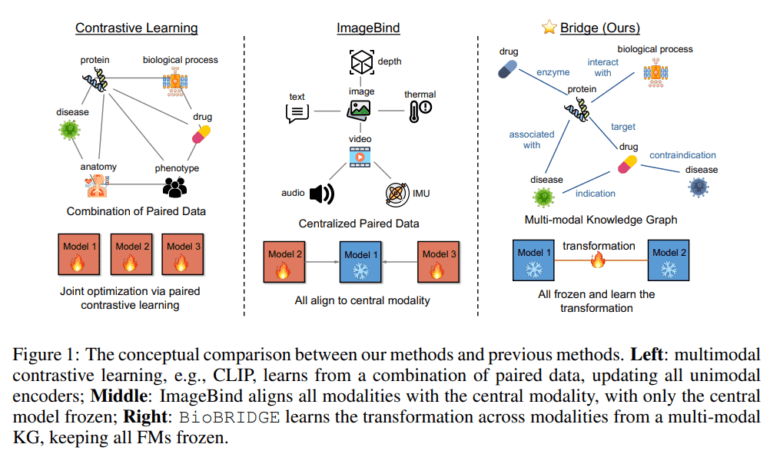- BioBRIDGE, a novel machine learning framework, bridges independently trained unimodal foundation models in biomedical research.
- Developed by a collaboration between the University of Illinois Urbana-Champaign and Amazon AWS AI.
- Utilizes Knowledge Graphs (KGs) to learn transformations between unimodal FMs without fine-tuning.
- Outperforms baseline KG embedding methods by approximately 76.3% in cross-modal retrieval tasks.
- Relies on rich structural information from biomedical KGs to align embedding spaces of unimodal FMs.
- Demonstrates proficiency in diverse cross-modal prediction tasks, even extrapolating to unseen data.
- Offers innovative applications, including biomedical multimodal question answering and drug discovery support.
Main AI News:
In the dynamic realm of biomedical exploration, the emergence of foundation models (FMs) has revolutionized our capacity to interpret and dissect extensive datasets devoid of labels across myriad tasks. However, within the biomedical landscape, these FMs have primarily functioned in unimodal capacities, concentrating solely on either protein sequences, small molecule structures, or clinical data in isolation, thus constraining their efficacy given the interconnectedness inherent in biomedical knowledge.
A collaborative effort between the University of Illinois Urbana-Champaign and Amazon AWS AI has yielded BioBRIDGE, a meticulously crafted learning framework engineered to amalgamate independently trained unimodal FMs and instigate multimodal behavior. This pioneering framework capitalizes on Knowledge Graphs (KGs) to discern transformations between unimodal FMs sans the necessity of fine-tuning the foundational models. Notably, empirical evidence showcases that BioBRIDGE surpasses baseline KG embedding methods in cross-modal retrieval tasks by a staggering 76.3%, underscoring its exceptional aptitude to extrapolate across uncharted modalities or relationships.
At the heart of BioBRIDGE’s modus operandi lies its utilization of biomedical KGs, repositories teeming with intricate structural data epitomized by triplets delineating head and tail biomedical entities alongside their correlations. This structural framework facilitates the comprehensive scrutiny of diverse modalities encompassing proteins, molecules, and diseases. By aligning the embedding space of unimodal FMs via cross-modal transformation models employing KG triplets, BioBRIDGE ensures data sufficiency and efficacy whilst circumventing the impediments posed by computational overheads and data paucity that often impede the scalability of multimodal methodologies.
BioBRIDGE’s efficacy is substantiated through a series of experiments showcasing its proficiency across a spectrum of cross-modal prediction tasks. Notably, it showcases the capacity to extrapolate to nodes absent from the training KG and generalize to relationships not present in the training dataset. Furthermore, it introduces a groundbreaking application as a universal retriever, augmenting biomedical multimodal question answering and facilitating the systematic generation of innovative pharmaceuticals.
Effortlessly bridging the chasm between unimodal FMs, BioBRIDGE harnesses the wealth of structural data within KGs to facilitate seamless cross-modal transformations. Its unparalleled prowess in out-of-domain generalization heralds new avenues for the integration and analysis of multimodal biomedical data. Positioned as a versatile instrument, this framework harbors the potential to profoundly influence biomedical research, ranging from fortifying question-answering systems to expediting the drug discovery process.
Conclusion:
BioBRIDGE represents a significant advancement in biomedical data analysis, enabling seamless integration and analysis of multimodal data. Its ability to outperform existing methods by a considerable margin indicates its potential to revolutionize various aspects of biomedical research and inform decision-making processes within the industry. This innovation opens doors to enhanced question-answering systems, streamlined drug discovery pipelines and, ultimately, accelerated advancements in healthcare and biotechnology. Companies operating in these sectors should closely monitor developments related to BioBRIDGE and consider its implications for their strategic planning and investments.

